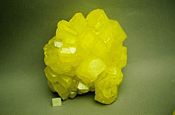Sulphur
| |||||||||||||||||||||||||||||||||||||||||||||||||||||||||||||||||||||||||||||||||||||||||||||||||||||||||||||||||||||||||||||||||||||||||||||||||||||||||||||||||||||||||||||||||||||||||||||||||||||||
Sulfur is a chemical element, typically found as a yellowish crystalline solid in its elemental form. It has the chemical symbol S, atomic number (number of protons) Z = 16, and a standard atomic weight of 32.065 g/mol.
Sulfur is widely used in the manufacture of sulfuric acid (H2SO4} as well as various fertilizers. The vast majority of the 66,000,000 metric tons of sulfur produced worldwide in 2006 was by-product sulfur recovered from petroleum refining and natural gas processing plants by the Claus process.[1]
Characteristics
At room temperature, sulfur is a soft, bright-yellow solid. Elemental sulfur has only a faint odor, similar to that of matches.
Sulfur burns with a blue flame that emits sulfur dioxide, notable for its peculiar suffocating odor due to dissolving in the mucosa to form dilute sulfurous acid.
Sulfur itself is insoluble in water, but soluble in carbon disulfide and to a lesser extent in other non-polar organic solvents such as benzene and toluene.
Common oxidation states of sulfur include −2, +2, +4 and +6. Sulfur forms stable compounds with all elements except the noble gases. Sulfur in the solid state ordinarily exists as cyclic crown-shaped S8 molecules.
The crystallography of sulfur is complex. Depending on the specific conditions, the sulfur allotropes form several distinct crystal structures, with rhombic and monoclinic S8 best known.
A noteworthy property of sulfur is that its viscosity in its molten state, unlike most other liquids, increases above temperatures of 200 °C due to the formation of polymers. The molten sulfur assumes a dark red color above this temperature. At higher temperatures, however, the viscosity is decreased as depolymerization occurs.
Amorphous or "plastic" sulfur can be produced through the rapid cooling of molten sulfur. X-ray crystallography studies show that the amorphous form may have a helical structure with eight atoms per turn. This form is metastable at room temperature and gradually reverts back to crystalline form. This process happens within a matter of hours to days but can be rapidly catalyzed.
